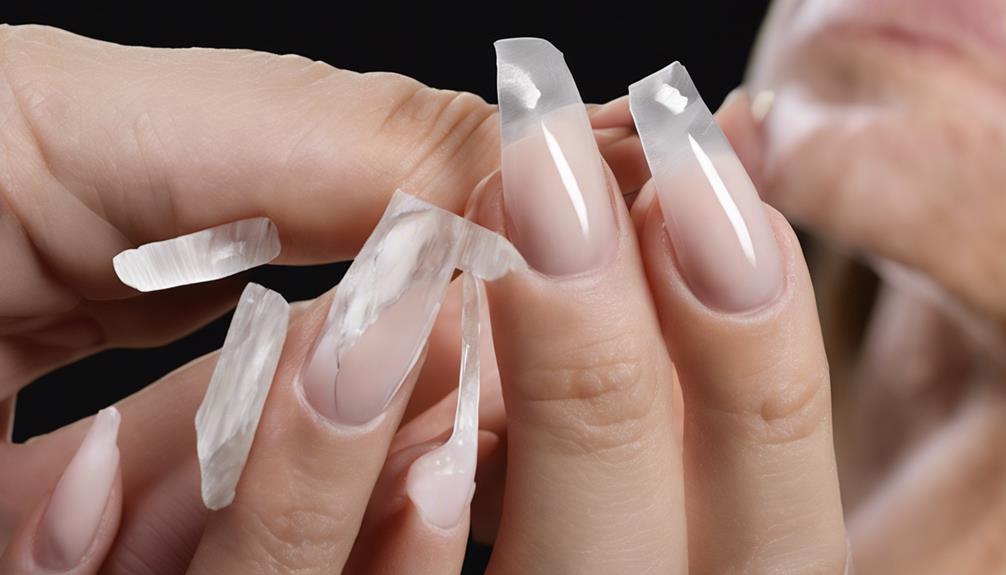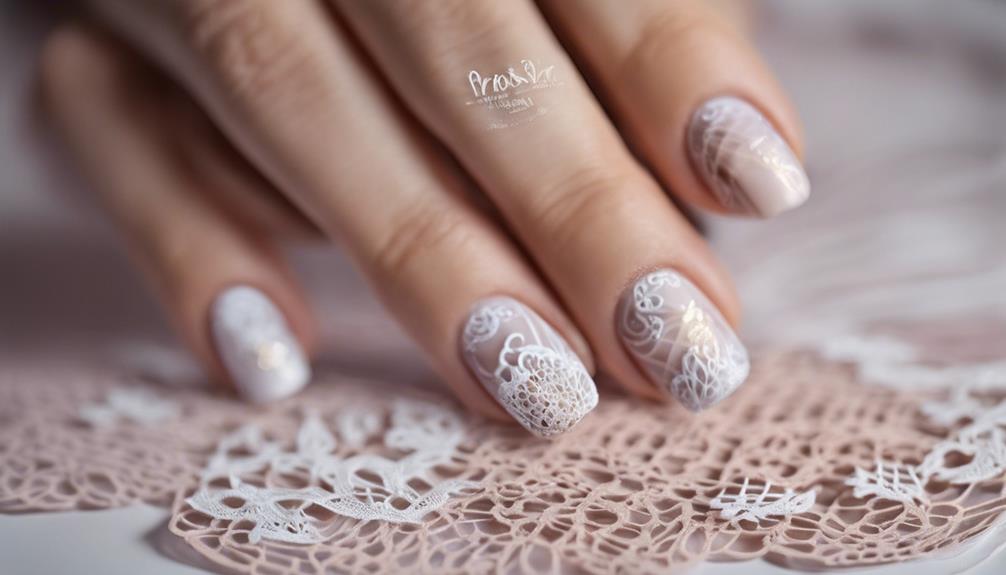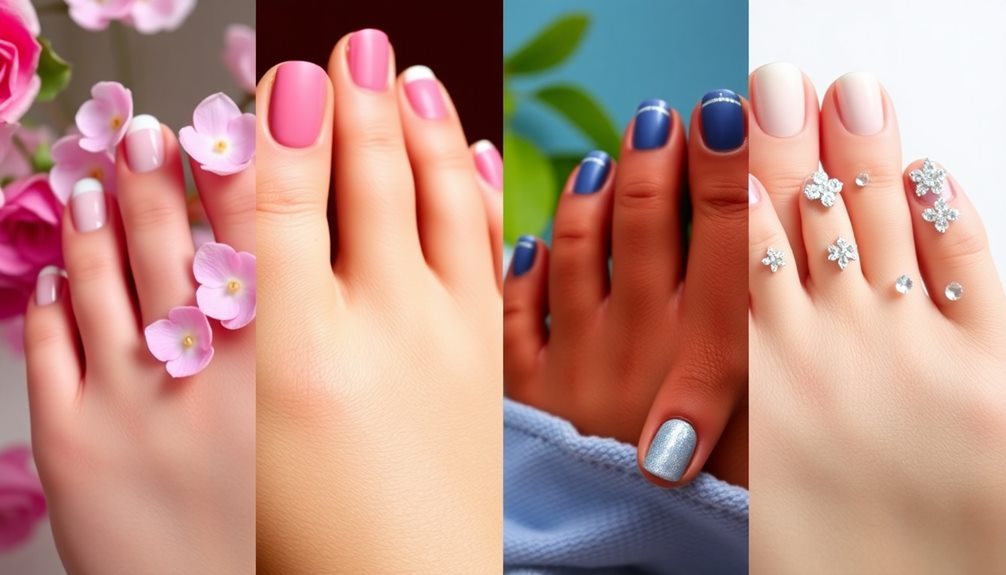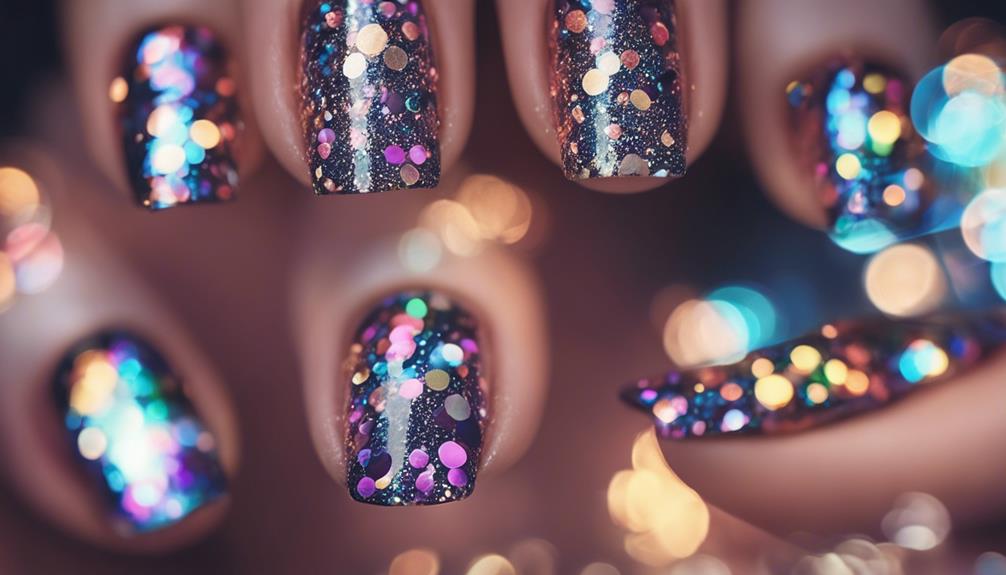If you accidentally tear off a real nail while wearing an acrylic one, it’s important to act quickly to properly treat the wound. Apply gentle pressure to stop any bleeding, disinfect the nail bed, cover it with a bandage, and consider taking ibuprofen for pain relief. Keeping the wound dry is crucial to prevent infections. Clean the area thoroughly, cover it with a sterile bandage, and watch for any signs of infection. It’s also a good idea to assess the severity of the injury, seek professional assistance if necessary, and use appropriate tools to carefully remove any loose nail. Remember to prioritize the health of the nail bed, allow it time to heal before getting new nail treatments, and be patient during the recovery process. Following these recommendations will help you maintain good nail care in the long run.
Key Takeaways
- Apply gentle pressure to stop bleeding and disinfect the torn nail bed.
- Carefully remove the lifted acrylic nail to promote healing of the nail bed.
- Keep the nail dry and covered with a clean bandage for protection.
- Monitor for signs of infection and ensure regular bandage changes.
- Refrain from new nail treatments until the nail regrows to prevent further damage.
Immediate First Aid Steps
When dealing with a torn acrylic nail, the immediate first aid steps are essential in preventing infection and promoting proper healing.
If a nail has been ripped off, the first thing to do is apply gentle pressure to stop any bleeding promptly. This not only helps in preventing further damage but also aids in reducing the risk of infection. Disinfecting the torn nail bed carefully is important to maintain cleanliness and minimize the chances of bacteria entering the wound.
Covering the injured area with a clean bandage shields it from external elements, safeguarding it during the healing process. Additionally, taking ibuprofen for pain relief can be beneficial, and keeping the nail dry is important for aiding in the healing process.
To further promote proper healing and prevent complications, it's recommended to clean the nail bed thoroughly after showering. These immediate first aid steps are essential for ensuring the well-being of the affected nail and surrounding skin.
Disinfection and Wound Care

Disinfecting the torn nail bed with an antiseptic solution is essential for preventing infection and promoting optimal healing. Here are key steps to guarantee proper disinfection and wound care:
- Clean the Area Carefully: After showering, delicately cleanse the nail bed to eliminate any debris or bacteria that could result in infection. Dab the area dry with a fresh towel to avoid moisture buildup.
- Apply a Sterile Bandage: Covering the wound with a sterile bandage helps shield it from external contaminants and fosters a hygienic environment for healing. Make sure the bandage is changed regularly to uphold cleanliness.
- Monitor for Infection Signs: Keep a close watch on the nail bed for any indications of infection, such as heightened redness, swelling, or discharge. If you observe any worrying symptoms, seek medical attention promptly to prevent complications.
Proper disinfection, bandaging, and monitoring are vital steps in caring for a ripped nail bed to support healing and prevent infections or irritations.
Assessing Nail Damage
After ensuring proper disinfection and wound care, the next step is to evaluate the extent of nail damage by examining the nail bed for signs of redness, swelling, bleeding, and pain. It's essential to determine the severity of the injury to understand how it may have damaged your nail bed. If the acrylic nail ripped off your natural nail, you may notice the nail cut, or even removed entirely. Evaluating the area will help in understanding the extent of the trauma and guide subsequent treatment.
When appraising the damage, consider the duration of the injury, noting when it occurred and any changes in symptoms over time. Take note of any abnormal signs like excessive bleeding, severe pain, or persistent swelling. By closely monitoring the healing process, you can observe normal signs such as yellow discharge indicating healing and expectant nail regrowth. Remember to seek advice for concerns regarding potential nail deformities, discoloration, and the best ways to take care of your nails post-injury.
Removing the Lifted Nail

To safely and effectively address a ripped acrylic nail, it's important to carefully remove the lifted nail using appropriate tools. When dealing with this situation, it's essential to take the necessary steps to guarantee the best outcome for the damaged nail bed. Here are three key considerations to keep in mind:
- Use the Right Tools: Utilize specialized nail tools to cut off the lifted acrylic nail without causing further harm to the underlying real nail. Precision is critical to prevent unnecessary trauma to the nail bed.
- Support the Nail: While cutting the acrylic, provide support to the nail to prevent the acrylic from shattering and potentially causing more damage. This technique helps maintain the integrity of the real nail bed during the removal process.
- Promote Healing: Removing the lifted acrylic nail allows for better visibility and care of the real nail bed. This process aids in promoting proper healing, reducing the risk of infection, and creating a favorable environment for the new nail to grow back. Remember, this process may take time, so patience is crucial.
Taking these steps with care and precision is essential in the initial management of a ripped nail bed.
Long-Term Nail Care

Long-term nail care involves consistent attention and patience to guarantee the proper healing and growth of the nail. Rushing the healing process can result in further damage and hinder the nail's proper regrowth. It's essential to manage the nail bed effectively to promote healthy nail growth. Refrain from undergoing new nail treatments until the nail has fully regrown to prevent any potential complications.
To make sure healthy growth, it's important to share helpful information with friends and family to raise awareness about the significance of long-term nail care. Educating oneself and others about the importance of patience in the healing process can lead to improved nail health and overall well-being.
Frequently Asked Questions
What to Do if Real Nail Comes off With Acrylic?
If real nail comes off with acrylic, seek immediate medical attention. Avoid reattachment attempts to prevent further damage. Keep the area clean, dry, and covered. Follow doctor's advice for best healing and regrowth.
How Do You Heal Your Nails After Ripping off Acrylics?
We clean the nail bed, apply antibiotic ointment, and keep it dry to heal nails after ripping off acrylics. Avoid pressure, monitor for infection signs, and seek medical help if needed. Let's promote healthy nail regrowth!
How Do You Treat a Ripped off Nail?
Treating a ripped-off nail involves cleaning the area, applying a bandage, and avoiding harsh chemicals. Our approach prioritizes gentle care, protecting the nail bed, and monitoring for signs of infection. Seek medical help if needed for best healing.
Should I Go to the Hospital if My Nail Ripped off With Acrylic?
If our nail ripped off with acrylic, seeking medical attention at the hospital is essential. Hospitals can provide immediate care, assess damage, prevent complications, and guide proper healing. Unsure? Don't delay – hospital care guarantees proper treatment and recovery.
How to Treat Torn Nails from Acrylics and Natural Nails Similarly?
When it comes to smashed toe nail treatment for torn nails from acrylics or natural nails, the first step is to clean the affected area. Trim any jagged edges carefully, then apply a gentle antiseptic and a bandage to protect the nail. Keep the area clean and dry to promote healing.
Conclusion
As we navigate the delicate process of healing and caring for our nails, remember that just like a ripped acrylic nail can be painful and challenging, so too can life's unexpected challenges.
By tending to our nails with care and patience, we symbolically nurture our own resilience and strength.
Let this experience serve as a reminder to treat ourselves with the same care and attention we give to our nails, for both will ultimately heal and thrive with time and care.









